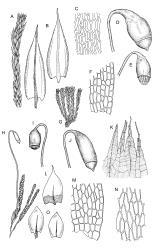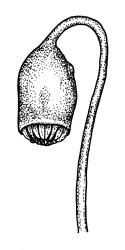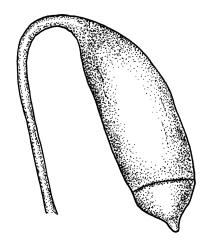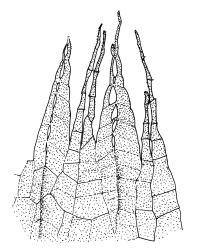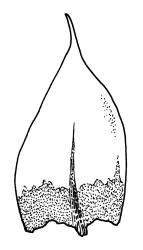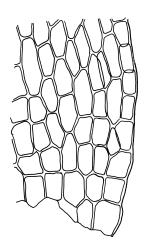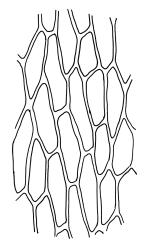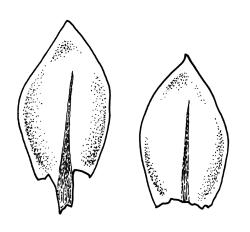Plants silver and hoary, forming low, loose or ± dense cushions. Stems pale green, orange, or pink, sometimes darker below, c. 5–20 mm, much branched (often with numerous short, fragile, bud-like branches), sparsely beset below with pale brown, nearly smooth rhizoids, in cross-section with firm-walled cortical cells and a distinct central strand. Leaves not comose, gradually more crowded and larger near tip of stem, closely imbricate both moist and dry, broadly ovate and acute, shortly apiculate, acuminate or rounded-obtuse at apex, 0.6–0.8(–0.9) × c. 0.4 mm (when not compressed) and with lamina 100% the total leaf length, strongly concave, green or pink at base, hyaline above (rarely to mid leaf), entire or rarely denticulate at apex of acumen, not bordered, plane, not decurrent; upper laminal cells rhomboid-hexagonal, colourless, and thin-walled near apex, firmer-walled below, c. 45–66 × 12–15 µm and 3–5:1, short-rectangular or quadrate in lower leaf; marginal cells not differentiated; basal cells quadrate and ± extending up margin, green. Costa rather thin, green, mostly ½ to ⅔ the leaf length, occasionally disappearing in acumen. Brood bodies (including tubers) absent in N.Z. material.
Dioicous. Perichaetia in branch axils; perichaetial leaves ovate-lanceolate, c. 1.2 mm long. Perigonia terminal (but often appearing lateral due to innovations), bud-like, with the inner bracts brown, but otherwise scarcely differentiated and enclosing numerous antheridia and sparse, filiform paraphyses. Setae 7–15 mm, red, cygneous just below capsule; capsules pendent, obovoid to oblong-cylindric, 0.85–2.0 × (0.5–)0.7–0.8 mm, with a poorly defined neck c. ¼ the total length and wrinkled when dry; operculum conic, apiculate. Exostome teeth yellow-brown below, pale and finely baculate above; endostome with narrowly perforate segments nearly equal the teeth, and paired, nodose or weakly appendiculate cilia. Spores 9–15 µm, smooth.
Crum & Anderson 1981, fig. 265; Seppelt 2004, fig. 36; Smith 2004, fig. 185, 1–3; Spence & Ramsay 2006, fig. 37, a–g.
The most characteristic feature of B. argenteum is the colourless, thin-walled cells of the upper lamina. These dead cells are readily observed at low magnifications in both living and herbarium material, but become more difficult to see when dried herbarium material is moistened. The dead cells give the plants its distinctive silvery appearance. Crum and Anderson (1981, p. 572) aptly describe the "silvery Bryum" as having leaves "tightly crowded on small, catkin-like innovations", which contrast with the pink or red capsules.
Bryum argenteum could be confused with the rare, pale, and often bud-like B. funkii; the differences between them are detailed under the latter species.
A weedy species occurring in a wide variety of terrestrial habitats (soil, peat, rock, mortar, concrete, asphalt, roofs, decomposed animal remains, etc.). Often associated with nitrogen enriched habitats. Common throughout, and especially common in urban areas. From sea level to at least 2300 m.
The smooth or nearly smooth rhizoids of this species are anomalous in a N.Z. context.
Given the variability of terrestrial habitats occupied by B. argenteum, its considerable variability in respect to leaf form and degree of pigmentation of the laminal cells is not surprising. The so-called "variety lanatum" is considered here to be a mere environmental growth form whose slenderly acuminate leaf apices are associated with drier habitats. In some such material (e.g., G.O.K. Sainsbury 1556 ex Lake Waikaremoana, Gisborne L.D., CHR 515869) the costa merges with the base of a denticulate acumen and appears excurrent.
Material of B. argenteum with rounded-obtuse leaf apices occurs very occasionally in N.Z. Such material (e.g., D.R. Given 12350 from Acheron Valley, Marlborough L.D., CHR 267940) is lax in its growth form, often has fragile stems, and has a large group of chlorophyllose cells at the leaf base. This material is considered here to be a growth form associated with shaded habitats and to be unworthy of taxonomic segregation.
Apparently similar material with rounded-obtuse leaf apices from various sites in Australia was discussed by Spence & Ramsay (2006) under the name B. subrotundifolium A.Jaeger. They described this taxon as having "obtuse leaf apices, often cucullate leaves, broad laminal cells, the absence of a hair-point or apiculus, and basal laminal cells that are rectangular rather than quadrate". However, an apparent isotype of B. subrotundifolium A.Jaeger (D. Sullivan s.n. from Mt Ararat, Victoria, CHR 637423) is wholly representative of B. argenteum and does not conform with Spence & Ramsay’s description. Seppelt (2004, p. 96) considered the relationship between B. argenteum and B. subrotundifolium in mainland Australia and continental Antarctica to require further study; it is considered here to be a taxon of dubious value. Ochyra et al. (2008) placed B. subrotundifolium A.Jaeger in the synonymy of what they termed B. argenteum var. muticum Brid. Further investigation of the identity and of the relationships of B. subrotundifolium are beyond the scope of this treatment.




